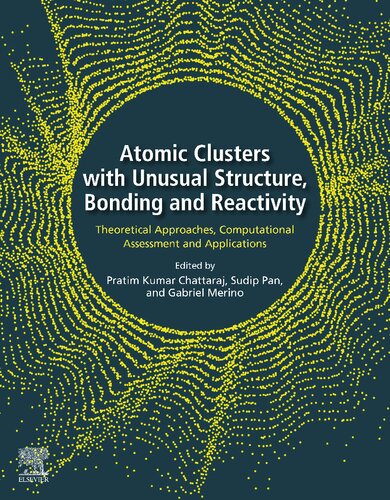Atomic Clusters with Unusual Structure, Bonding and Reactivity: Theoretical Approaches, Computational Assessment and Applications – eBook PDF
$50.00 Original price was: $50.00.$35.00Current price is: $35.00.
Atomic Clusters with Unusual Structure, Bonding and Reactivity: Theoretical Approaches, Computational Assessment and Applications – Ebook PDF
SKU: EB-49167238
Categories: Mathematics, Science
Tags: Atomic Clusters, Gabriel Merino, Pratim Kumar Chattaraj, Sudip Pan, Unusual Structure
Atomic Clusters with Unusual Structure, Bonding and Reactivity: Theoretical Approaches, Computational Assessment and Applications – Ebook PDF Instant Delivery – ISBN(s): 9780128229439,0128229438,9780128231012, 0128231017

Product details:
- ISBN-10 : 0128231017
- ISBN-13 : 9780128231012
- Author: Gabriel Merino, Pratim Kumar Chattaraj, Sudip Pan
Atomic Clusters with Unusual Structure, Bonding and Reactivity: Theoretical Approaches, Computational Assessment and Applications reviews the latest computational tools and approaches available for accurately assessing the properties of a cluster, while also highlighting how such clusters can be adapted and utilized for the development of novel materials and applications. Sections provide an introduction to the computational methods used to obtain global minima for clusters and effectively analyze bonds, outline experimental approaches to produce clusters, discuss specific applications, and explore cluster reactivity and usage across a number of fields. Drawing on the knowledge of its expert editors and contributors, this book provides a detailed guide to ascertaining the stability, bonding and properties of atomic clusters. Atomic clusters, which exhibit unusual properties, offer huge potential as building blocks for new materials and novel applications, but understanding their properties, stability and bonding is essential in order to accurately understand, characterize and manipulate them for further use. Searching for the most stable geometry of a given cluster is difficult and becomes even more so for clusters of medium and large sizes, where the number of possible isomers sharply increase, hence this book provides a unique and comprehensive approach to the topic and available techniques and applications.
Table contents:
Chapter 1 – Describing chemical bonding in exotic systems through AdNDP analysis
Chapter 2 – Electron delocalization in clusters
Chapter 3 – Bimetallic clusters
Chapter 4 – Unusual bonding between second row main group elements
Chapter 5 – Conceptual density functional theory and all metal aromaticity
Chapter 6 – Structural evolution, stability, and spectra of small silver and gold clusters: A view from the electron shell model
Chapter 7 – Optical response properties of some metal cluster supported host-guest systems
Chapter 8 – Group III–V hexagonal pnictide clusters and their promise for graphene-like materials
Chapter 9 – M(L)8 complexes (M = Ca, Sr, Ba; L = PH3, PF3, N2, CO): Act of an alkaline-earth metal as a conventional transition metal
Chapter 10 – Structures, reactivity, and properties of low ionization energy species doped fullerenes and their complexes with superhalogen
Chapter 11 – Generation of global minimum energy structures of small molecular clusters using machine learning technique
Chapter 12 – Studies on hydrogen storage in molecules, cages, clusters, and materials: A DFT study
Chapter 13 – A density functional theory study of H3+ and Li3+ clusters: Similar structures with different bonding, aromaticity, and reactivity properties
Chapter 14 – Designing nanoclusters for catalytic activation of small molecules: A theoretical endeavor
Chapter 15 – Molecular electrides: An overview of their structure, bonding, and reactivity
Chapter 16 – Hydrogen trapping potential of a few novel molecular clusters and ions
Chapter 17 – Polarizability of atoms and atomic clusters
Chapter 18 – Advances in cluster bonding: Bridging superatomic building blocks via intercluster bonds
Chapter 19 – Zintl cluster as a building block of superalkali, superhalogen, and superatom
Chapter 20 – Metallic clusters for realizing planar hypercoordinate second-row main group elements and multiple bonded species
Chapter 21 – Planar hypercoordinate carbon
Chapter 22 – Transformation of nanoclusters without co-reagent
Chapter 23 – Application of frustrated Lewis pairs in small molecule activation and associated transformations
Chapter 24 – Ligand-protected clusters
People also search:
Atomic Clusters with Unusual Structure, Bonding and Reactivity: Theoretical Approaches, Computational Assessment and Applications
How is atomic structure related to chemical bonding
What does the structure and bonding of a substance give us a good idea of
What is an atomic cluster
What is the significance of atomic bonding


